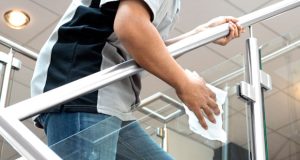 James White, Managing Director at Denis Rawlins, explains why returning retail and hospitality businesses need to invest in their post-lockdown cleaning regimes to ensure they are COVID-secure.
James White, Managing Director at Denis Rawlins, explains why returning retail and hospitality businesses need to invest in their post-lockdown cleaning regimes to ensure they are COVID-secure.
The UK lockdown has slowly begun to lift in recent months, after many industries were forced into a COVID-19 induced hibernation back in March. Since early June, we have seen the eagerly-awaited return of retail, leisure and hospitality, with shops, bars and restaurants opening their doors to customers.
Numerous measures have been introduced to ensure the safety of staff and customers. From protective screens across bars and adequately distanced restaurant tables, to retail staff wearing masks and visors, and sanitising stations placed at key access points.
But while many are keen to get back to some normality, others have their reservations and are holding back from activities like shopping and dining out, despite the government’s encouragement to do so.
Many fear that the risk of transmission is still high, and without a vaccine in place, we are solely relying on hygiene and social distancing measures. This places a great pressure on businesses to protect both their staff and customers, through rigorous cleaning regimes.
Managers must be able to show returning visitors that they have put everything in place to safeguard their health and wellbeing. They need to win the trust of these anxious consumers and instil confidence, if they are to bounce back to pre-lockdown days.
Cleaning plays a major role in this. Gone are the days where a quick wipe over a bar or table will suffice. And it most certainly is the time to chop the mop on shop floors – and everywhere else for that matter. It’s time to move away from sub-standard cleaning practices completely.
In fact, we need to adopt a whole new approach to cleaning. Including the over-reliance on disinfectant. What many people don’t realise is that using disinfectants can actually be counterproductive. Like the losing battle of antibiotics against superbugs, they become increasingly ineffective over time.
Although the solution may kill most bacteria, it doesn’t remove them, leaving dead microbes, along with any surviving germs, spread across the surface. And these microbes, dead or alive, serve as a food source for the next wave of bugs. Some bacteria also produce biofilms that can effectively defend them from cleaning agents. So, there is a real danger that disinfectant only increases the bacterial resistance, rendering it ineffective after consistent use.
Over the past few months, we have created a simple three-step COVID-19 cleaning process that removes dirt, improves procedures, and protects the environment from bacteria and viruses. We call this the ‘Remove, Improve, and Protect’ method.
Remove
There is no excuse for using mop buckets and rags or wipes in an attempt to clean surfaces. The dirt needs to be removed, not pushed around by an unhygienic, archaic method.
The only way to eliminate dirt on hard surfaces is by adding water and the correct chemistry, and removing the used solution, either through high-flow fluid extraction on floors or by using a squeegee on tables and bars. This cannot be done with wipes on tables and mops on floors – a new process must be employed that guarantees removal of all soils.
This cleaning process should be carried out at regular intervals, ideally daily, to ensure that the removal of the day’s dirt is all that is required – a simple task when using the correct techniques.
Improve
All cleaning should be process-driven and continuously improve cleanliness levels each time. Using a high-flow fluid extraction process will enable significant improvements from the very first time it is used, enabling cleaners to consistently deliver high standards of hygiene.
The effectiveness of the process can then be measured by taking adenosine triphosphate (ATP) measurements before and after cleaning, to ensure that surfaces are not just clean, but free of germs.
Protect
The final step of the process should always be to protect the surfaces with a solution like the Zoono Z-71 Microbe Shield, which is a cost-effective, residual polymer-based antimicrobial protection.
The solution provides 30-days active protection for any treated surface, significantly reducing the spread of harmful bacteria and viruses, giving a unique, proven, long-lasting barrier protection. We recommend that main touch points are treated every seven days, with the wider area fogged or sprayed every 21 days for the very best hygiene. Routine cleaning can continue between applications, without disrupting the Zoono molecule or its antimicrobial activity.
If the COVID-19 crisis has taught us anything, it’s that only the highest standards of hygiene can tackle bacteria and viruses head on. By adopting our ‘remove, improve and protect’ cleaning strategy, businesses can be confident that their premises are safe for the wider workforce and customers in the post-lockdown world.
For further information on our equipment and processes visit https://www.rawlins.co.uk/remove-improve-protect-covid




